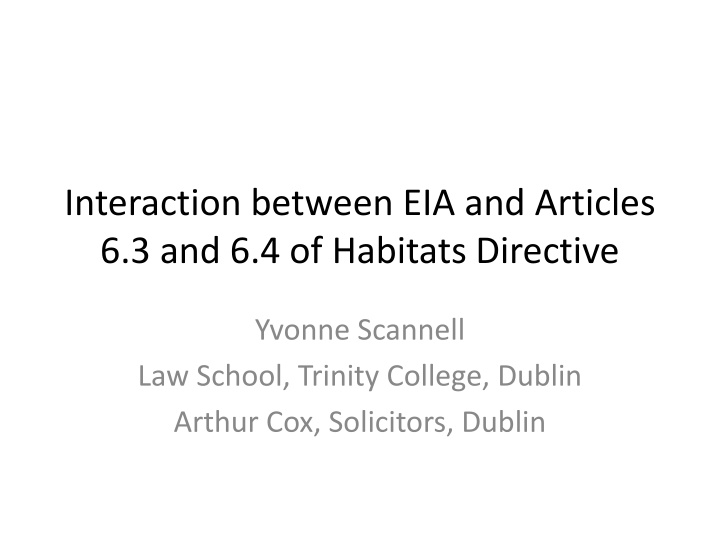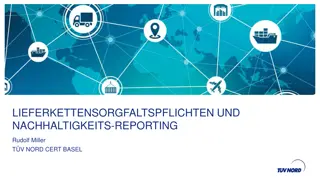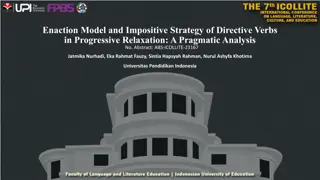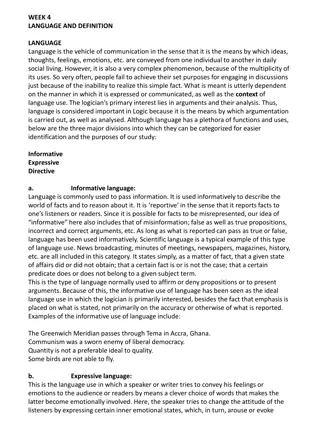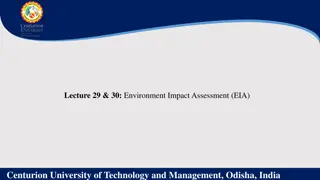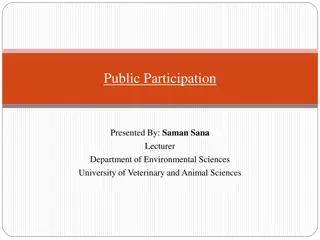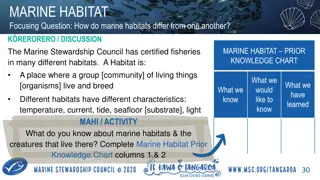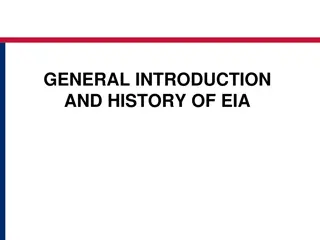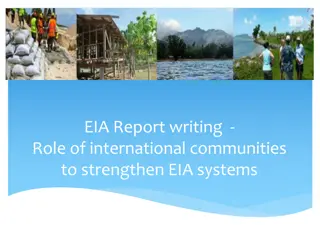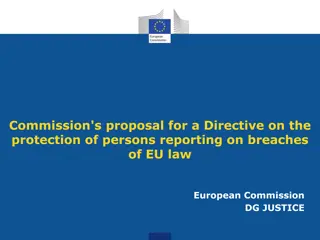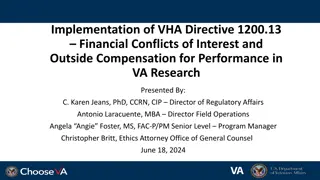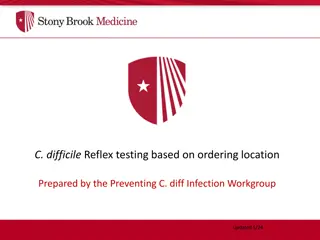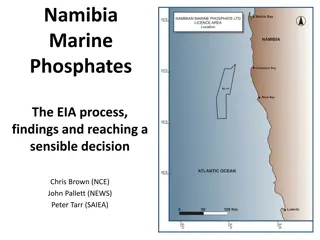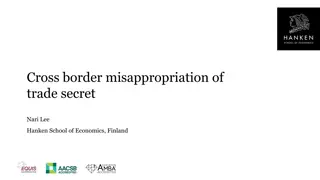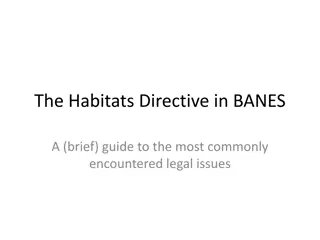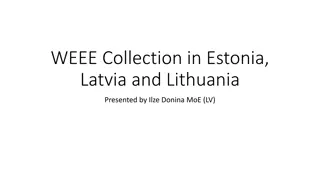Interaction Between EIA and Habitats Directive Articles 6.3 & 6.4
Analyzing the relationship between Environmental Impact Assessment (EIA) and Articles 6.3 & 6.4 of the Habitats Directive. Explore exemptions, publication requirements, screening, and mitigation measures in this legal context.
Uploaded on Feb 20, 2025 | 1 Views
Download Presentation

Please find below an Image/Link to download the presentation.
The content on the website is provided AS IS for your information and personal use only. It may not be sold, licensed, or shared on other websites without obtaining consent from the author.If you encounter any issues during the download, it is possible that the publisher has removed the file from their server.
You are allowed to download the files provided on this website for personal or commercial use, subject to the condition that they are used lawfully. All files are the property of their respective owners.
The content on the website is provided AS IS for your information and personal use only. It may not be sold, licensed, or shared on other websites without obtaining consent from the author.
E N D
Presentation Transcript
Interaction between EIA and Articles 6.3 and 6.4 of Habitats Directive Yvonne Scannell Law School, Trinity College, Dublin Arthur Cox, Solicitors, Dublin
Cf EIA to AA Can apply to any kind of plan or project big or small- including EIA projects Art.6.3. Requires EIA for listed projects only.
Exemptions Exemptions for defence projects, projects adopted by legislation and in exceptional cases EIA Directive, Arts.1.3, 1.4, 2.4. Only exemption is if the plan or programme is directly connected with or necessary to the management of the site . Art 6.3
Publication requirements for screening Annex 11 screening decisions to be publicly available and ECJ says reasons must be given for them if requested. No explicit obligation to publish screening decisions but they must be available to requesting third parties. Methological Guidelines say reasoning and decision to be published
SCREENING & MITIGATION Mitigation measures may/must be considered when screening for EIA subject to satisfying certain criteria. Methological Guidelines say no but argued mitigation measures can be considered but criteria for mitigation measures arguably somewhat stricter when screening for AA
Screening tests Environmental features must be likely to be affected to justify requiring EIA Directive, Art.5.1.a If there is a mere probability that the plan or project will have effects, or if there is a risk or doubt re significant effects or it cannot be excluded that there will be significant effects, AA required. Waddenzee, para 45 Pfizer proportionality principle applies to risk assessment
WHAT HAS TO BE STUDIED? Likely significant effects on the environment as defined in the EIA Directive. Significant effects to be assessed (on all the environment) theoretically very extensive Applies to plans and projects likely to have a significant effect on a site in view of the site s conservation objectives
CUMULATIVE EFFECTS Applies to cumulative effects of various projects. Applies to cumulative effects of plans or projects either alone or in combination with other plans or projects
QUALITY OF INFORMATION REQUIRED Information required is having regard, inter alia, to current knowledge and methods of assessment in so far as it is reasonable to ask developer to provide. Information for assessment to be based on best scientific knowledge. (Requirements excellence, independence and transparency. )
Affected environment different for each The environment which will likely be affected may possibly be unknown when the project is proposed. The aspects of the site to be protected will be ascertainable from the conservation objectives specific to the site which reflect the ecological requirements of the natural habitat types and species in Annex 1 and 11 .
Consultation Public consultation mandatory EIA Directive Arts.4.4, 5.2, 6, 7, 8, 9, 11. Aarhus. Public consultation if appropriate for Stage 2 Art.6.3. Required if Aarhus applies
Must the assessment be written? No explicit requirement for written assessment of EIS but ECJ implies it English and Irish courts say reasoned decision on conclusions of the AA required.Methological Guidelines say yes.
Outcomes of assessment In principle projects can be authorised even if there are better alternatives. In principle, plans and projects adversely affecting site integrity of site cannot be approved. Article 6.3 Unless ROPI
Alternatives Only alternatives considered need to described but some competent authorities have invented ways of requiring a proper examination of alternatives Project cannot be allowed unless there is NO alternative and unless there are reasons of overriding public interest.
Compensatory measures No obligation on Member State/developer to take compensatory measures if significant adverse effects on the environment. Obligation on Member State to take all compensatory measures to ensure that the overall coherence of Natura 2000 is protected
Obligation to consult Commission Obligation to inform Commission of reasons for exemption from EIA under Art.2.4 No obligation to justify negative screenings in Habitats Directive to Commission.
Procedures Procedures for EIS and EIA prescribed in detail No prescribed procedures for AA
Aarhus Convention is part of the acquis Picture of a brown bear!
Transboundary issues EIA Directive requirement to involve other Member States significantly affected by project No requirement in Habitats Directive to involve other MS. But.. Aarhus rights of public participation, access to information and access to justice Aarhus rights to be implied Espoo
Some remedies EIA Directive, Complaint against State to Espoo Compliance committee but..MOX Habitats Anyone in any State party or NGO can complain against another State party to Aarhus Compliance committee Directive obligations can be enforced in domestic courts Complaint to Commission Directive obligations can be enforced in domestic courts Complaint to EU Commission
Publicity for decisions and reasons Obligation to publish screening decision, final decision and reasons and considerations for it. Aarhus and Art 10 A No express requirement to publish decisions but implied. Aarhus
Aarhus Obligation to implement Aarhus requirements on access to justice EIA Directive, 10A Aarhus doesn t apply to Habitats but CJEU has stated that it should!
EU Commission No requirement to get Commission s consent for permitting significant adverse effects on environment Obligation to notify compensatory measures Obligation to get EU Commission s opinion on the reasons of OPI justifying plan or project affecting priority site or priority species. Art.6.4
